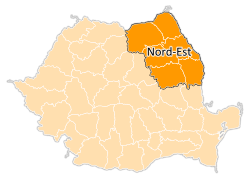Nord-Est (development region)
Nord-Est | |
|---|---|
Region | |
 | |
| Country | |
| Development Agency HQ | Iași |
| Largest city | Iași |
| Area | |
| • Total | 36,850 km2 (14,230 sq mi) |
| Population (2011) | |
| • Total | 3,302,217 |
| • Rank | 1st |
| • Density | 90/km2 (230/sq mi) |
| Ethnic groups | |
| • Romanians | 97.9% |
| • Roma | 1.2% |
| • Ukrainians | 0.3% |
| Time zone | UTC+2 (EET) |
| • Summer (DST) | UTC+3 (EEST) |
| NUTS code | RO21 |
| GDP per capita (PPS) | €11,600 (2017)[1] |
| HDI (2017) | 0.768[2] high · 8th |
| Website | http://www.adrnordest.ro/ |
Nord-Est (Template:Lang-en) is a development region in Romania. As other development regions, it does not have any administrative powers, its main function being to co-ordinate regional development projects and manage funds from the European Union.
Counties
The region covers the Northeast part of the country and, traditionally, it is a part of the old historical region of Moldavia (mainly, Western Moldavia and southern Bukovina). The Nord-Est region is made up of the following counties:
Economy
The Nord-Est Region is an area with a rich historical, cultural and spiritual background. Geographically, the region goes from mountain ranges in the west, towards the gentle plateaus with important vineyards, and rolling plains with large farms in the east. It is also one of the tourist destinations in Romania.
The economy of Nord-Est region is mixed, agricultural, especially towards the east, and with a number of industrial centres. The regional GDP per capita is the lowest in Romania, at about two-thirds of the national average.
Main cities:
- Iași, the former capital of Moldavia and the largest city in Nord-Est, has a strong industrial base and is one of Romania's main university, cultural, arts and business centers;
- Bacău is a dynamic industrial and commercial centre;
- Suceava (the mediaval capital of Moldavia) and Piatra Neamț were also industrialized cities, and are important historical and tourism based cities;
- Botoșani and Vaslui are traditional developed trade and agriculture centers, and important bases for the regions textile and processing industries.
- Bârlad, Roman, Onești and Pașcani are other important industrial based cities in the region.
Demographics
Nord-Est has a total population of 3,302,217 (2011 Census)[3] making it the most populated region in the country. Its population density is 90/km².
At the 2002 census, the region had a significant Romanian majority, of 97.9%, with the second largest minority being the Romani, who make up 1.2% of the population. Other minorities, which include Ukrainians, Lipovans, Csangos, Poles, Hutsuls, Hungarians, and Germans make up the rest of the population (0.9%).
Romanian is the most widely spoken language, spoken as a first language by 98.7% of the inhabitants of the region. Minority languages include Romany, spoken by 0.6% of the population, and Ukrainian (0.3%).
See also
References
- ^ Eurostat (26 February 2019). "GDP per capita in 281 EU regions in 2017". Europa web portal. Retrieved 27 February 2019.
- ^ "Sub-national HDI - Area Database - Global Data Lab". hdi.globaldatalab.org. Retrieved 2018-09-13.
- ^ "Population at 20 October 2011" (in Romanian). INSSE. January 2014. Retrieved 9 February 2014.

